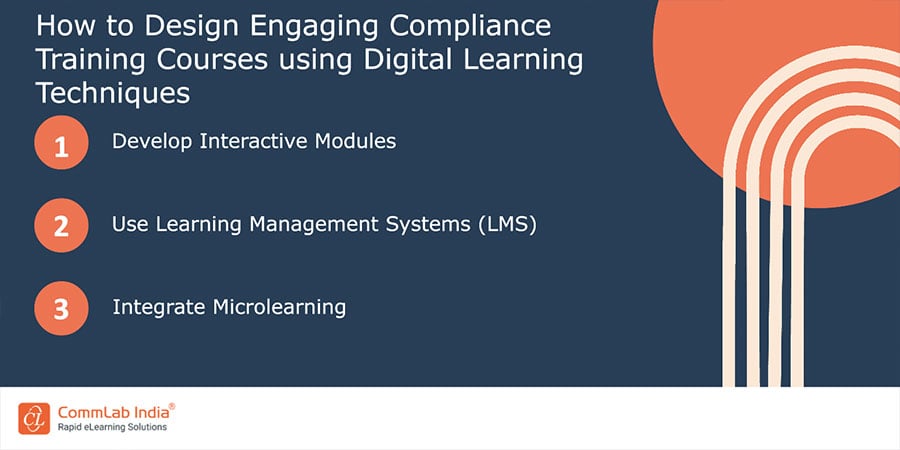6 Salient Advantages of Using Digital Learning Strategies for Compliance Training
How to make compliance training enlivening? Well, try digital learning! Explore how in this blog.

Compliance training plays a significant role in any organization. It helps the employees in understanding the ethical and legal standards required for functioning in an organization. It also aids in mitigating various related risks and promotes a healthy culture that respects integrity. In this fast-changing digitalized world, conventional training methods, such as instructor-led training sessions, are slowly being replaced by new-age methods, such as digital learning. In this blog, we will take a detailed look at why digital learning is one of the best methods to conduct compliance training and discuss how you can use various digital learning formats to elevate the quality of your corporate training sessions.
Wondering How to Enliven Compliance Training?
Digital learning can make a difference as it offers:
- Increased Engagement
- Higher Flexibility
- Interactive capabilities
- Real-time reporting and progress tracking
- Consistency in content delivery
- Cost Effective
What is Digital Learning?
For corporate L&D managers aiming to broaden the appeal of their training initiatives, digital learning is a potent tool. By embracing the digital revolution, you may lower costs and do away with the requirement for time off work by providing employees with access to learning whenever and wherever they want. There are many different formats available for digital learning, including eLearning, microlearning, Virtual instructor-led training, and mobile learning. These formats enable the development of tailored learning opportunities and memorable narrative-driven blended learning experiences. You may modernize corporate training and promote performance enhancement within your company using digital learning.
6 Salient Advantages of Using Digital Learning Strategies for Compliance Training:
1. Increased Engagement: Compliance training sessions can be somewhat dry. They consist of lengthy dos and don’ts, legal obligations, and regulations. Digital learning techniques offer the trainees various interactive elements, which can help greatly in enlivening these sessions. These include simulations, gamification elements, quizzes, and multimedia. The incorporation of these elements results in much more engaging courses that trainees can benefit from. Furthermore, the integration of highly engaging course materials and techniques ensures that trainees can fully immerse themselves in real-world applications of the training materials.
Instructors can use multimedia tools to translate real-life case studies into an engaging matter that helps trainees in fostering critical thinking and sharpens their decision-making skills. Moreover, the engaging format results in increased active participation on the trainees’ level, increasing the chances of them retaining most of the information and giving them the ability as well as the confidence to apply the retained information correctly in their job.
2. Higher Flexibility: Digital learning techniques score one over conventional training methods owing to the fact that they can be highly flexible in nature. Conventional training methods require the trainee and the trainers to be present in a specific physical location at a particular time, which can prove to be disruptive to their schedules, as well as time-consuming. Digital learning techniques, on the other hand, allow the trainers to design the courses that allow trainees to engage with them according to their schedules. These materials can be accessed anywhere, at any time, and most of them, such as mobile learning, feature multi-platform support, offering even higher flexibility. These courses, such as eLearning courses, are also self-paced, offering trainees the chance to revisit some of the content that they had trouble understanding completely in one go. Furthermore, as proven by a 2018 LinkedIn study, this high flexibility coupled with the opportunity for growth also helps in employee retention.

3. Interactive Capabilities: By using digital learning methods, L&D Specialists include various interactive elements in their courses, enabling trainees to discover the potential applications of recently gained information. eLearning courseware designers can include exciting new media, such as detail simulations, virtual reality or augmented reality support, and branching scenarios. Trainees can actively participate in realistic scenarios that can help them in compliance when they crop up in real life. Furthermore, it also allows them to play our various scenarios in the training itself, try and make decisions to meet the compliance standards with any real-life consequences. Utilization of interactive elements ensures enhanced understanding, improved critical thinking, and strong problem-solving skills of the learners.
4. Real-time Reporting and Progress Tracking: When opting for digital learning, the course designers and trainers have the option of building robust reporting and instant tracking features. This allows them to gain real-time insights regarding progress as well as the performance of the trainees. L&D managers can use learning management systems (LMS) to easily monitor the trainees’ completion rates, quiz and test scores, and other performance markers. These LMS platforms also offer learning analytics, making it easier for the L&D managers to track and evaluate learners’ progress.
These platforms also allow them to gain instant feedback from the trainees that can be further used to enhance the quality of course materials and content. Most importantly, these markers can be effectively used to fulfill the necessary requirements from regulatory bodies as admissible evidence of having offered compliance training.
→ Download eBook: Top eLearning Trends 2023
5. Consistency in Training Delivery: Conventional forms of compliance training can display certain inconsistencies in terms of content delivered. Every training course depends on a human factor from the trainer, which can lead to differences in the interpretation of the course materials. Digital learning techniques, on the other hand, offer consistent content delivery, set benchmarks for progress tracking, and hard evidence of having imparted the compliance training. This consistency aids the trainees as they all receive the same content. Consistently delivered, with progress and feedback tracked. This also allows the L&D managers to pinpoint what aspects work and which ones don’t, making the evaluation and enhancement process easy.
6. Cost Effective: Switching out conventional compliance training with digital one has one huge benefit – it costs less. Digital learning negates all the expenses related to booking a space, printing course materials, renting required assets, and travel/ accommodation/ food. Once fully developed, digital-based courses can be deployed countless times and they can also be reconfigured and updated based on changing requirements. Furthermore, these courses can be accessed by a large number of trainees at the same time, resulting in a lower cost of training per individual. With new policies and guidelines making their way frequently, digital learning is certainly an impactful and cost-effective approach to facilitate compliance training.
How to Design Engaging Compliance Training Courses using Digital Learning Formats:

1. Developing Interactive Modules: Course designers can use interactive eLearning technologies to increase the effectiveness of their compliance training sessions. They can use multimedia elements, such as images and videos, offer the trainees a chance to implement their newly found knowledge using a hyper-realistic simulation, create complex scenarios that require critical thinking, and include gamification elements. These interactive training sessions can be delivered using LMSs.
2. Integrating Microlearning: Digitalization of compliance training can heavily benefit both trainers and trainees as these digital courses can be designed using microlearning Trainers can design these courses in the form of short, bite-sized learning sessions. This helps trainees to consume the required information in small portions, which ultimately increases their chances of retaining most of it.
Watch the following video to learn more about creating engaging compliance training courses.
Parting Ways
Digital learning offers numerous benefits when it comes to compliance training. Ranging from increased flexibility to enhanced learning experience, the power of digitalized training sessions aids both trainers as well as trainees. Trainers can use these techniques to increase engagement, promote active participation, enhance knowledge retention, and foster a healthy culture of compliance in the organization. Wondering how you can learn more about various digital learning strategies and how they can play an important role in your training sessions? Access this free eBook now.




